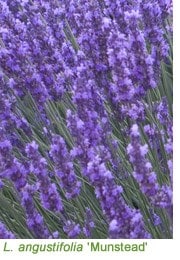English lavenders

When the heat bounces off the ground and almost overwhelms you some plants are revelling in this heat. On scorching days in high summer you won’t have to touch the foliage at all, it will waft through the air providing an aromatherapy session for the gardener that’s both relaxing and soothing.
Whether it’s the lavender, sage, rosemary or thyme throughout the year you can massage their oily foliage and smell their rich aroma. This oily coating is a sunscreen and many of the plants are either silver, a colour that doesn’t absorb much heat, or have needle-like leaves to cut down on water loss. However any aromatic plant must have a sunny position in well-drained soil. It will sulk in any shade.
 Lavenders were prized by the Romans, often for their antiseptic properties. They brought them here and they’ve been here ever since, becoming an essential part of the English garden. Lavender oil was added to Roman bath water as a soothing and relaxing addition - the name comes from the Latin ‘lavare’ to wash. Lavandula angustifolia has been prized here for centuries and has become known as English lavender. It’s the hardiest of all, with narrow leaves and summer flowering short spikes of flower held just above the foliage.
Lavenders were prized by the Romans, often for their antiseptic properties. They brought them here and they’ve been here ever since, becoming an essential part of the English garden. Lavender oil was added to Roman bath water as a soothing and relaxing addition - the name comes from the Latin ‘lavare’ to wash. Lavandula angustifolia has been prized here for centuries and has become known as English lavender. It’s the hardiest of all, with narrow leaves and summer flowering short spikes of flower held just above the foliage.
There are several named forms including the classic purple flowered ‘Hidcote’, a variety brought to England by Major Lawrence Johnstone of Hidcote Manor in Gloucestershire in the 1920s. It’s a stronger colour, a deep purple, and it’s the best lavender for a hedge because it’s low-growing, compact and showy.
A newer
English lavender called
‘Imperial Gem’, selected by Norfolk Lavender in the 1960s, is taller in habit with thicker spikes and this is the best deep blue
English lavender. The more violet ‘
Munstead’ will give you a softer look.
 English lavenders, always listed under L. angustifolia, are the hardiest of all - and the longest lived. A correctly pruned lavender of this type will look lovely and vigorous twenty years on, but will then need replacing. The flowers of English lavender appear during Wimbledon fortnight or there abouts and, if you wish to dry them, this is the time to pick and bunch them. Hang them upside down to dry in a warm but dark place. Many use their wardrobes. If you’re using lavender bushes as an accompaniment to roses, you can cut away a third of the growth in early May to delay the flowering time by a month so that the lavender follows on after the roses. This is the common practice at The National Trust’s Mottisfont Abbey in Hampshire.
English lavenders, always listed under L. angustifolia, are the hardiest of all - and the longest lived. A correctly pruned lavender of this type will look lovely and vigorous twenty years on, but will then need replacing. The flowers of English lavender appear during Wimbledon fortnight or there abouts and, if you wish to dry them, this is the time to pick and bunch them. Hang them upside down to dry in a warm but dark place. Many use their wardrobes. If you’re using lavender bushes as an accompaniment to roses, you can cut away a third of the growth in early May to delay the flowering time by a month so that the lavender follows on after the roses. This is the common practice at The National Trust’s Mottisfont Abbey in Hampshire.
Pruning English lavender needs to be done in August to encourage lots of bushy new growth in September. Be radical, cut it back hard to within three to six inches (7 - 15cm) so that the lavender regenerates before winter arrives. In mild winters the bushes can carry on growing, but they can be trimmed again in April should this happen. After a hard winter, there may be dead wood. Cut this away to the new shoots in mid-April.






